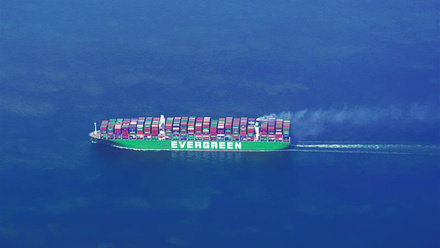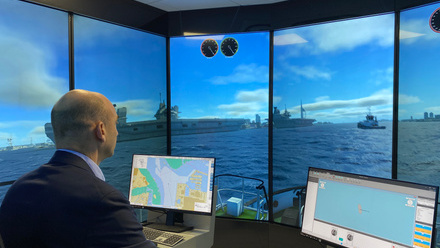Five maritime trends to watch in 2025
From slowing down older bulk carriers to the increasing scrutiny of green claims, we predict what will grab the headlines next year and beyond.
1/ Autonomous technologies set to revolutionise data collection
There’s still so much we don’t know about the ocean at a time when it has never been more important to understand its mysteries, whether as a shared resource for food, transport and energy or a driver of climate in our changing world.
The good news is that new technologies are creating opportunities to truly revolutionise the collection and management of ocean data, with advances in autonomous vehicles, connectivity and computational power converging to help unlock ocean secrets.
This trend is gaining real traction, with a flotilla of uncrewed autonomous vessels set to patrol the remote oceans, collecting ocean data in a scaleable, sustainable network.
Such an example is revealed by Will Alexander, Campaign Lead for Maritime Autonomous Systems at BMT, which, in collaboration with Ocius, plans to deploy a fleet of 1,000 renewable-energy-propelled autonomous vessels – known as ‘Bluebottles’ – globally within the next decade.
“To enable sustainable marine development and help manage the impacts of a changing climate, there is an urgent need to better understand and observe our seas and oceans,” says Alexander, a qualified master mariner and hydrographic surveyor with a Masters in Hydrography from the University of Plymouth, where he also studied Oceanography and Meteorology. “Maritime autonomous systems and other disruptive technologies hold the key to achieving this at the pace and scale required.”
2/ Digital disruption to upgrade maritime education
Online modules and virtual webinars are already an established part of maritime training, from mandated courses for seafarers to content customised for particular shipowners. However, increased connectivity from services such as Starlink plus the flexibility of open-source learning management systems like Moodle will increasingly enable continuous learning for those at sea.
Generative AI should accelerate these trends, making online education increasingly the default – even for more hands-on subjects. The algorithms will recognise patterns in how users respond in order to customise and personalise learning and enhance simulation training.
Engineer and lecturer Kalyan Chatterjea, FIMarEST, who has considerable involvement in maritime education and training in Singapore and Malaysia, expects Arduino-based systems – an open-source electronics platform with easy-to-use hardware and software – to provide realistic experience in automation and control.
These technologies mean it’s easier than ever to scale and customise learning across the workforce, and deliver content in ways that are both more affordable and more convenient for the end-user. But as Chatterjea points out, it’s important to educate the educators so they can really leverage these technologies.
“Upskilling maritime lecturers will ensure they are equipped to teach the latest technologies,” he explains. “By embracing these trends, maritime education can prepare the next generation of seafarers to navigate the challenges and opportunities of the future.”

3/ Fair winds boost wind-assist propulsion orderbooks
2024 was a big year for shipping’s wind-assisted propulsion revolution, with order books filling up at leading suppliers such as bound4blue (suction sails), MOL (hard sails) and Anemoi Rotor Sails (Flettner rotors).
EU research has forecast that up to 10,700 wind propulsion installations could be in place by 2030 covering 50% of the bulker market and up to 65% of tankers. The main challenges are initial investment costs and the relatively new status of the technology, although early movers are providing real-world proof of concept, including double-digit savings in fuel and emissions.
Daniel Mann, CCO of bound4blue, which in November landed its largest contract win to date with a deal to supply 20 of its eSAIL® suction sails to shipping giant Maersk Tankers, says the niche is growing rapidly.
“Wind [is] finally being accepted as one of the prime enablers for a greener maritime future,” states Mann.
There are still hurdles to overcome before the technology goes mainstream but based on current trajectory and momentum, 2025 could well be another breakthrough year.
4/ It’s go-slow for older bulk carriers
Shipowners grappling with the best way to ready their fleets for the latest rounds of emissions regulations are running the numbers over a range of options, from newbuilds to retrofits, new fuels to electrification.
Some shipowners working with less time-sensitive cargoes such as iron ore, bauxite, coal and other commodities are taking a more pragmatic approach to fixing their fuel burn: they have slowed down.
If a vessel reduces its speed by just one knot, it can result in a 9% decrease in greenhouse gas emissions. For owners of older bulk carriers built with less-stringent design criteria than newer ships, slow steaming is a viable way to trim fuel consumption.
“Before the market spike for bulk carriers in 2021, newer vessels were travelling five percent faster on average than older vessels and we are not far from that again,” according to Oliver Kirkham, Valuations Analyst at Veson Nautical, who has been analysing the data over the last decade. “Our data supports the concept of an emerging two-tier market because as the bulk carrier fleet ages, a premium can be levied on newer, faster vessels.”
It may not grab the headlines in the same way as expensive newbuilds or new fuel technology, but slow steaming is a trend we may see more owners embrace in 2025 as an economic workaround to the challenges of decarbonisation.

5/ Increased scrutiny of green claims
As weather patterns become more extreme, there’s increased scrutiny of the decarbonisation efforts currently underway across multiple industries. Whether it’s burning wood pellets from Virginian forestry plantations in UK power stations or building direct air capture plants to suck CO2 direct from the air to offset heavy polluters, the path to net zero can be lost in a fog of complex and sometimes unconvincing carbon calculations.
The shipping industry is not immune, with Alex St James, founder of PsiDN, a maritime risk management consultancy focused on decarbonisation, saying the high profile green newbuilds running on expensive, renewable fuels like ammonia or methanol are “loss leaders in a calculated game of regulatory arbitrage”.
St James, who has a master’s degree in Naval Architecture, said a handful of green vessels improve the environmental credentials of the fleet, allowing operators to comply with the latest regulatory demands.
“Instead of confronting the deep, systemic transformation that true decarbonisation requires, the shipping industry is tinkering at the edges,” he says. “Because while these token vessels might help the industry meet its emissions targets on paper, they do nothing to shift the fundamental reliance on fossil fuels that powers the majority of ships sailing the seas today.”
St James points out that the industry is nowhere near ready to give up its addiction to fossil fuels because of the supply constraints, infrastructure limitations and eye-watering costs of the green alternatives. But whatever their motivation, he applauds those shipowners that are pioneering green fuel ships because this real-world testing will help inform the next leap forward.
“They’re testing the limits of [alternative] fuels, uncovering operational challenges, and pushing the boundaries of what’s possible,” he concludes. “This isn’t about idealism, it’s about pragmatism. The shipping industry has to start somewhere, and these vessels are offering a glimpse of the future we need.”
Main image: a bulk carrier freight ship; credit: Shutterstock.
Inline image 1: digital concept of bound4blue’s suction sails on Maersk vessels; credit: bound4blue.
Inline image 2: Alex St James, founder of PsiDN; credit: Alex St James.
Tell us what you think about this article by joining the discussion on IMarEST Connect.






